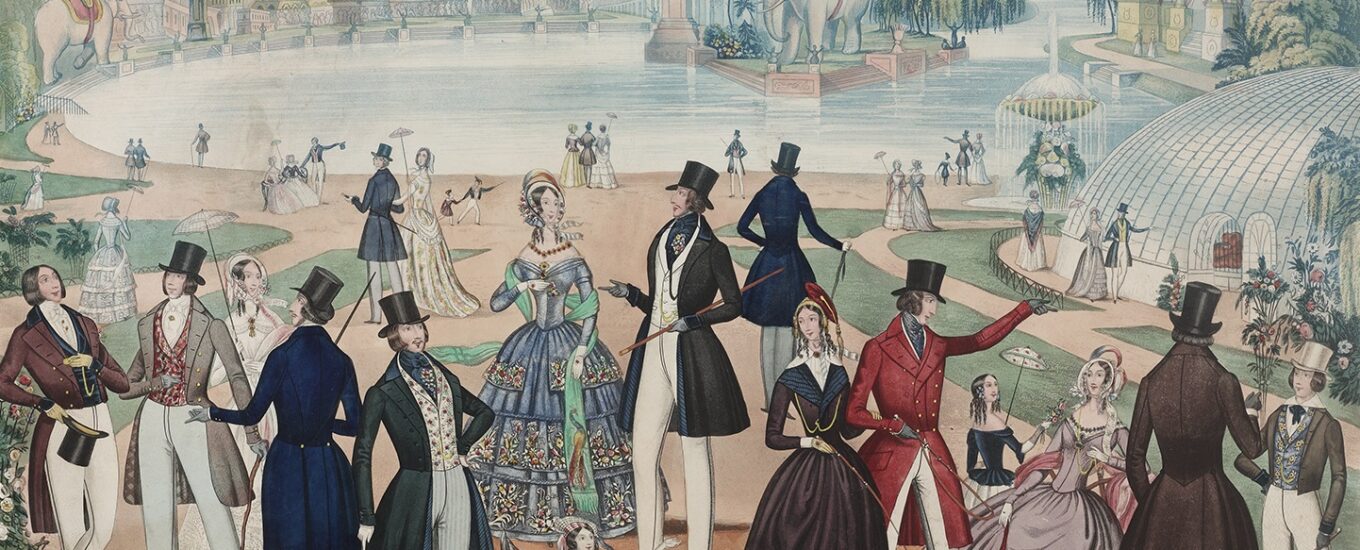Lost Gardens of London: Surrey Zoological Gardens
STORIES

Extracted from Lost Gardens of London by Todd Longstaffe-Gowan, curator of our current exhibition Lost Gardens of London: The Royal Surrey Zoological Gardens in Walworth, Southwark, were a modern zoological collection ‘with novelties introduced’, conceived in 1831 by its projectors, Edward Cross and Henry Phillips, as a ‘place of healthful amusement’, for the ‘promotion of zoology’ and ‘the most attractive lounge in or near the metropolis’. Cross had made his reputation as the keeper of the Menagerie at Exeter-Change (the capital’s largest exotic animal emporium), and Phillips was a celebrated author, landscape gardener and botanist. The new gardens were adorned with statues and ‘little gothic and other ornamental edifices’, diversified with parterres and lawns, threaded with gravel paths and profusely stocked with ‘specimens of trees from almost every part of the globe, labelled with their English and scientific appellations’. The whole was also laid out around an expansive sheet of water covered with waterfowl of every variety and encompassing two wooded islands. The Eagle Rock was not the only rockwork to be raised in the gardens: several craggy promontories were scattered across them, harbouring fountains and providing habitations for reptiles, birds and quadrupeds. Among the more unusual was the Tortoise’s Grotto.

The Surrey Gardens, as they became known, were an instant and popular success: C. F. Partington declared in National History and Views of London and its Environs (1834) that ‘the great taste displayed in the arrangement of these gardens, and the careful selection of animals, render it worthy in every respect the extensive patronage it has hitherto received’,32 and a contributor to Paxton’s Magazine of Botany, and Register of Flowering Plants (1834) affirmed that, though some of his readers might level the criticism that Cross’s giant menagerie, with its multitudinous birds, beasts, cages and compartments, was ‘not much connected with the culture of plants’, the ‘distance is not so great as at first sight may appear’. The skill of laying out such a piece of ground, ‘whether that ground is to be occupied by either plants or animals’, was, he believed, to give equal consideration to both with a view to creating a complete work of art.

Besides the attractions of the menagerie, the gardens – unlike those of the London Zoological Society in Regent’s Park – had frequent flower shows, balloon ascents, and a succession of ‘Splendid New Spectacles!’ Here, the phenomenon of the modelled, three-dimensional panorama, lashed up with great quantities of paper, canvas, plaster and timber, cleverly painted, reached its zenith. Some of the ‘Colossal Pictorial Typorama’ staged between 1837 and 1856 included ‘Views of Naples, [the] Eruption of Vesuvius, and Destruction of Herculaneum and Pompeii, in the year 79’, ‘The Great Fire of London’, a ‘View of the Town and Bay of Gibraltar’, ‘The Passage of the Alps by Napoleon and his Army’ and a ‘Great Picture of the Temple of Janus in Imperial Rome’. George Danson was the genius behind the gardens’ giant ‘Allegorical Pictorial Tableau[x]’, and his ‘new Stupendous Panoramic Model al-fresco, of Wondrous Caverns, Subterranean Palaces, and far-famed excavated temples of elora, the greatest Marvel of India’ was declared by a contributor to the Sun as ‘decidedly the most novel and extraordinary Pyro-Scenic Display ever imagined!! The advance of the Fire God on his floating Throne of Flaming Dragons, and brilliant Apotheosis of Vishnu nightly received with rapturous bursts of delight and astonishment!!!’.

It was remarked in the Atlas that the painting of the ‘rock-hewn’ structures was so ‘skillfully executed as to convey a very excellent idea of the extraordinary mountain excavations, which excite wonder and admiration of every traveller in India’. Mr Southby’s pyrotechnical displays were also commended for their ingenuity and novelty. The spectacles at ‘this very intellectual place of amusement’ invariably took place by the lake and generally at dusk, so that it was ‘impossible to distinguish the real features of the View from the artificial’. The ‘sumptuous tank’ formed a natural and reflective amphitheatre and was reported at the time to have given the performances ‘a motion and vitality not to be suggested by any other means’.